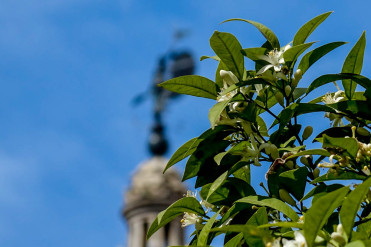Holy Week in Seville
- María Molina

- Apr 10
- 4 min read
In this post you will find information on how Easter is celebrated in Seville.
Holy Week is celebrated with special solemnity in many towns and cities in Spain. Religious images from the temples are carried through the streets of the city in what are called processions. The images are arranged on highly decorated platforms called “pasos” and are accompanied by brothers belonging to religious organizations called “cofradías” or “hermandades” (brotherhoods). These images can be of Jesus Christ, the Virgin Mary or Gospel scenes. In every place there are particularities, but they are always an expression that mixes tradition with devotion.
If there is a place where all this is special, this place is Seville. Sevillians get involved in Holy Week, either as participants or as spectators, accompanied by a climate that is usually very mild, and the smell of "azahar" (orange blossom) and incense with which the processions pass by. The oldest brotherhoods in Seville date back to the XIV and XV centuries and between the “Friday of Sorrows” (Friday before Holy Week) and “Easter Sunday”, more than 70 brotherhoods take to the streets..
Each brotherhood usually carries two "pasos" and involves about 2,000 people, who are organized in different sections of the procession, which begins with various "estandartes" (banners), preceding the "pasos"

The most numerous members of the procession are the “nazarenos”, who wear tunics, sometimes a cape, and a mask that is shaped with a cardboard cone called a “capirote”. The colors and insignias are different for each brotherhood.

The “nazarenos” are arranged in two rows and carry candles.
The procession begins with a Cross of Guide ("Cruz de Guía")

There are two types of “pasos”: The “pasos de palio” which carry an image of the Virgin Mary under a canopy and the "pasos de Cristo", which carry an image of Jesus Christ alone or in a Gospel scene. Each confraternity usually carries two pasos, one of each type.
The "pasos" are mounted on a structure that allows people underneath. The people who carry the "pasos" on their backs are called “costaleros” because they help themselves with a sack ("costal") that they put on their heads to lift the "paso". The "costaleros" do not see the outside, so they are guided by the instructions of a foreman ("capataz").
The "pasos" are very heavy (the heaviest "paso" in Seville weighs 3,500 k. and is carried by 60 "costaleros"), so it is necessary to rest after a certain amount of time. The period between two rests is called "chicotá", and "levantá" is the act of raising the paso again after a rest. To synchronize the raising of all the costaleros, the "llamador" is used.
Behind the pasos walk a special type of "nazareno" who does not carry candles, but crosses, and a mask without a hood. They are called penitents "penitentes".

Behind the "pasos" and, in some cases, before the Cross of Guide, music bands play the so-called processional marches.

The "nazarenos" usually give candies, images of the images, called "estampitas", or wax from the candles to the children who are watching the procession, and they form balls of wax. This used to be done so that the children would not be frightened by the appearance of the "nazarenos", but it is now a more general custom.
On Maundy Thursday and Good Friday many women wear the traditional "mantilla" to attend religious functions or to witness processions.

In certain places along the route, the pasos are sung to them from the balconies. The song is called "saeta"
In short, a lot of information ... But I think you will understand the following video better this way.
Ejercicios de español
1.-Este _______ tiene mucha experiencia y dirige muy bien al paso.
2.-Esos costaleros se están ajustando el ______
3- ¡Qué guapa esta esa chica con la ________!
4.- ¡Calla!. Están cantando una _____ desde ese balcón
5.- La cruz que llevan los __________ es de madera
6.- Es un ____ impresionante. No me explico como puede pasar por calles tan estrechas
7.- No se como los costaleros han aguantado una _______ tan larga
8.- Está anocheciendo, y van encender los ______ los nazarenos
9.- Tengo un amigo que sale de nazareno en el tercer _____ del paso de palio
10- Ya se acerca la procesión, estoy viendo la ____________
11- Me encanta tanto el paso de _____ como el paso de ______ de esta cofradía
12.- Este año tengo que hacerme el ________ nuevo porque se mojó y ha perdido la forma
Ejercicios:
1.-Este capataz tiene mucha experiencia y dirige muy bien al paso.
2.-Esos costaleros se están ajustando el costal
3- ¡Qué guapa esta esa chica con la mantilla!
4.- ¡Calla!. Están cantando una saeta desde ese balcón
5.- La cruz que llevan los penitentes es de madera
6.- Es un paso impresionante. No me explico como puede pasar por calles tan estrechas
7.- No se como los costaleros han aguantado una chicotá tan larga
8.- Está anocheciendo, y van encender los cirios los nazarenos
9.- Tengo un amigo que sale de nazareno en el tercer tramo del paso de palio
10- Ya se acerca la procesión, estoy viendo la Cruz de Guía
11- Me encanta tanto el paso de palio como el paso de Cristo de esta cofradía
12.- Este año tengo que hacerme el capirote nuevo porque se mojó y ha perdido la forma
¿Te ha gustado la entrada? ¿Te ha parecido interesante?
Apóyame con un "like", un comentario o difundiéndola a tus amigos.
Suscríbete y estarás al día
Estoy a tu disposición para responder a tus preguntas
Gracias por leerme






































Comments